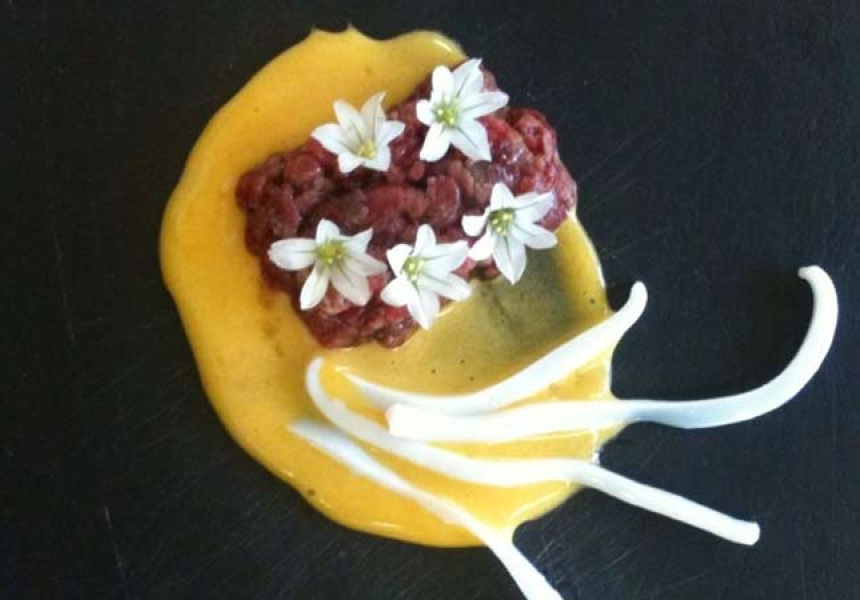At Loam restaurant, 98 per cent of the dishes served return to the kitchen plate scraped clean. The other two percent come back with an assortment of leftovers pushed to the side, usually bits that diners assume are garnish – and here the prettiest casualties are the flowers.
“A small percentage of people pick the flowers off and leave them,” says head chef and co-owner of Loam, Aaron Turner, as we discuss flowers on the menu at his Bellarine Peninsula restaurant.
“I’m not really sure if they do it because of personal taste, or if it’s because they don’t really think of flowers as food, laughs the chef, who often turns up local flowers on his daily foraging trips for the restaurant’s menu.
We think you might like Access. For $12 a month, join our membership program to stay in the know.
SIGN UP“We’re currently using wild garlic flowers, pickled rose, wild turnip flowers [sweet with a mild turnip taste] and bud saltbush, which is sweeter than the bush itself,” says Turner, when prompted for some of his more unusual floral menu items. It’s a fairly lengthy list and – as spring spreads its mellow tones – one that’s growing.
Despite that tiny two percent who pick these delicate items off, Turner believes that most diners today are beginning to understand the use of flowers in the culinary landscape. But he’s quick to point out that they should be used with sensitivity and purpose to add more than visual excitement to a dish.
“They are pretty, but I use them mainly because they carry unique flavours that you really can’t get any other way,” says the chef, who recently honed his skills at one of the world’s top restaurants, Noma.
“I use them when I’m looking for a particular flavour. For the wild garlic we serve with raw wagyu, I really wanted something strong and familiar, but I was also looking for a flavour that was not too overpowering. It’s about so much more than just the visual aspect; it has to make sense in the dish.”
Flowers as food are not a new idea: 13th Century Moorish recipes required syrups flavoured with rosewater, British cookbooks have long included herb flowers such as rosemary, basil and dill, and painstakingly sugared violets have been used as cake decorations since Medieval times. But fresh flowers have recently re-entered the Melbourne culinary landscape thanks to restaurants including Loam, Carlton’s Embrasse and the CBD’s Vue de Monde, where flowers become an integral feature of the dish, rather than just dressing, and might include anything from lavender toppings to petal salads.
It’s this development of culinary flowers that Anthony Boermans, owner and manager of Micro Mania, has seen developing over the years.
“I was first aware [of culinary flowers] about 20 years ago when boxes of salad mix came out,” says the Melbourne supplier of micro greens. “The high-end product had marigold petals mixed through it and it was a very special product. So the added colour of flowers has been part of salads for years.”
But things have changed a fair bit since that marigold mix and today Boermans’ list of culinary flowers includes Vietnamese mint, borage, chive, calendula, nasturtium, evening primrose, viola and rose petals, as well as edible snapdragons – the variety limited only by a cook’s imagination.
But it’s more than just the look and flavour of our dishes that benefits.
“Nasturtiums have a lot of betacarotene when eaten,” says Melbourne herbalist, naturopath and broadcaster Gill Stannard. “Plants with reds and deep yellows have good amounts of betacarotene for vitamin A, while borage flowers (which are sometimes sold as borage or star flower oil) have essential fatty acid, which is good for hair and nail growth.” And these can only be good things when added to the diet in a variety of forms.
But with so many exotic flowers on offer to liven the kitchen, where do you start? For Boermans it’s got to be nasturtiums.
“You can eat the leaf and flower and it’s peppery with a lot of flavour, but not overpowering,” he says.
For Tuner, getting to know the garlic flower, with its mild garlic and onion tones, is a great place to start. But he also recommends getting well acquainted with as many different types as you can, to find the ones that work for you.
“Taste as many as you can and see what you think. Ask lots of questions and read lots. A good resource when you’re getting started is the botanical gardens and their gardeners. They know what’s in season and have some great tips. That’s how I taught myself.”
So from pretty finishing touches, to subtle flavours or a vitamin hit, there’s certainly no doubt about it – flowers in the kitchen aren’t just for decoration.
Note: if you are thinking of gathering flowers for culinary use, make sure you get them from a clean and reliable source where they have not been sprayed with chemicals. As a general rule, flowers from florists may have been treated to keep them looking fresh.
www.loamrestaurant.blogspot.com
www.embrasserestaurant.com.au
www.vuedemonde.com.au
DIY
Micro Mania
Leo’s Fine Food
More Info
Gill Stannard- Naturopath
Royal Botanic Gardens Melbourne

